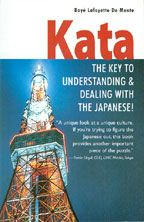
Kata: The Key to Understanding & Dealing with the Japanese
By Boyé Lafayette De Mente
Tuttle, 2003.
ISBN: 0-8048-3386-9.
168 p. 5" x 8" paperback.
Purchase from Amazon. (paid link)
You could easily fill a bookshelf with the books that have been written about understanding Japanese culture and how to successfully deal with the Japanese in business settings. The classics, like Ruth Benedict's The Chrysanthemum and the Sword, Robert Christopher's The Japanese Mind , and Edwin Reischauer's The Japanese Today: Change and Continuity, still provide useful insights for martial artists outside of Japan who are engaged in the struggle to provide a Japanese context for their arts. And while kata is frequently addressed in these sorts of books, I've never seen the concept used to focus a description of the Japanese mentality quite so accurately and successfully as in Boyé Lafayette De Mente's new book Kata: the Key to Understanding & Dealing with the Japanese. De Mente shoots down the myth of the inscrutable Japanese, writing in his foreword, "In fact, the Japanese have always been among the most explainable people on Earth due to their deeply entrenched custom of formalized role-playing, which influence[s] every aspect of their attitudes and behavior." Once you've grasped this key notion, much that was once opaque about Japanese society and culture becomes more transparent--at least that's what happened to me when I read this book.
The book is a rather loosely organized collection of essaylets, grouped into the broad categories of "The Kata Factor," "The Kata-ization of Japan," "Kata in Japan Today," "Kata in Business," "Weaknesses of the Japanese System," and "Can Japan Survive without Kata?" After a brief overview of kata in Japanese society, its pervasiveness and importance, and a short history of the concept, De Mente provides numerous examples of specific social and business interactions and explains in detail precisely what is going on, delineating the underlying kata assumed by the Japanese. These situations are entirely authentic--I've experienced personally virtually all of them during my decade in Japan; in a few cases I had no idea that others had experienced the same thing.
Since kata, albeit in a slightly different incarnation, happens also to be the key to understanding and training in the koryu, this book is enormously enlightening. The author is particularly good at pinpointing the causes of Western frustration when dealing with the Japanese. If you've ever had reason to wonder about your Japanese teacher's behavior, you'll appreciate the explanations in this book. There are plenty of eye-opening jewels that will help the Western koryu practitioner in training, understanding, and transmission, despite the book's emphasis on business matters.
The book is not flawless--the prose does not soar, and De Mente's description of kata in the martial arts is superficial, and correct only from a fairly limited point of view. The informational content of this book, however, makes it required reading for anyone presently involved in the transmission of a koryu outside of Japan, as well as for anyone planning an extended stay in Japan.
Diane Skoss

Contact Koryu.com
Last modified on October 23, 2019
URL: https://koryu.com /books/kata.html
Copyright ©2022 Koryu Books. All rights reserved.
